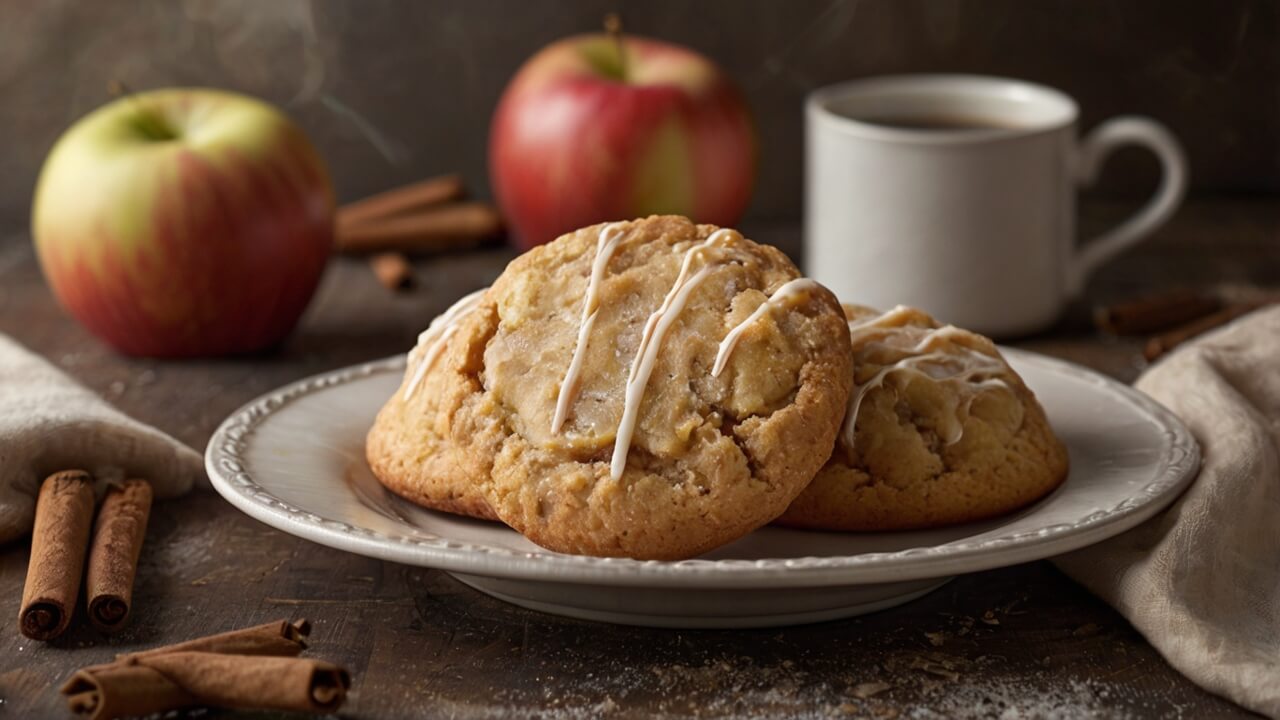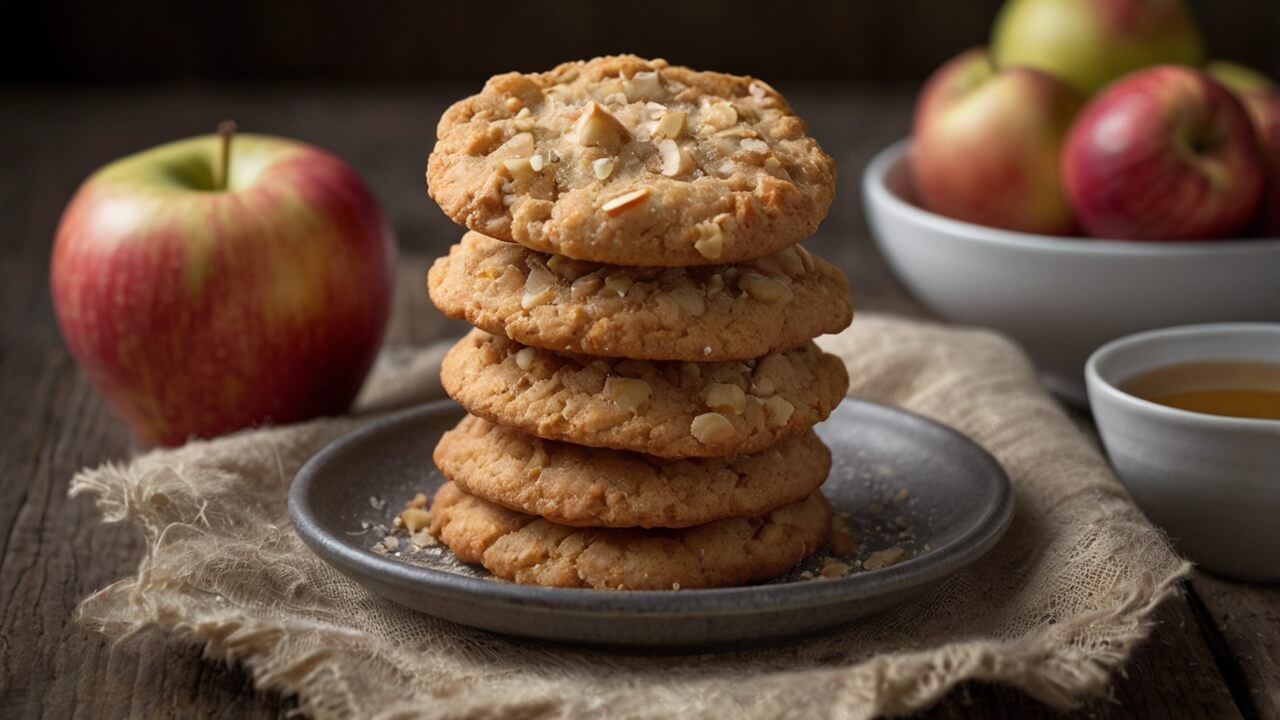A.P. Cookies, also known as Apies or Apees, are a beloved and historical treat that has graced American kitchens for generations.
These thin, crispy butter cookies are a treasured part of the nation’s culinary heritage, with their origins deeply rooted in the traditions of the Pennsylvania Dutch community.
The name “A.P.” is believed to be derived from Anne Parmer, a renowned baker in the 18th century whose delectable cookies gained widespread popularity.
These delicate, yet flavorful treats have become a cherished symbol of American baking ingenuity, celebrated for their simplicity and ability to transport taste buds through time.
Beyond their delightful taste, A.P. Cookies hold a special place in American culture, often associated with festive occasions and family gatherings.
Whether enjoyed during the holidays, at community events, or as a delightful accompaniment to afternoon tea, these cookies have become a beloved tradition, passed down from one generation to the next.
Origins and History

A.P. Cookies, also known as Apies or Apees, have a rich history deeply rooted in American culinary traditions. The name “A.P.” is believed to be derived from “Anne Parmer,” a woman whose recipe for these crisp, buttery cookies was published in the late 18th century. However, the exact origin of the name remains a subject of debate among food historians.
These cookies trace their origins back to the Pennsylvania Dutch community, where they were a beloved treat enjoyed during festive occasions and holidays.
As the recipe spread across the region, it evolved and adapted to different family traditions, resulting in slight variations in ingredients and baking techniques.
Historical cookbooks, such as Eliza Leslie’s “Seventy-Five Receipts for Pastry, Cakes, and Sweetmeats” published in 1828, featured recipes for “Apees” or “Apeas,” offering a glimpse into the early iterations of these delectable treats.
Food historian William Woys Weaver has extensively researched the history of A.P. Cookies, shedding light on their cultural significance and the role they played in the lives of early American settlers.
Over time, A.P. Cookies became a beloved tradition, passed down from generation to generation, with each family adding their own unique twist to the recipe.
These crisp, buttery delights have stood the test of time, becoming an enduring part of American culinary heritage and a cherished treat for special occasions and holidays.
Traditional Occasions

A.P. Cookies have a long-standing tradition in American culture, particularly in regions with strong Pennsylvania Dutch influences. These crisp, buttery treats have been a staple at various celebrations and holidays for generations.
One of the most prominent occasions for baking and enjoying A.P. Cookies is Christmas. Their simple yet delicious flavor and festive shapes make them a beloved addition to holiday cookie trays and gift baskets.
The cookies’ crisp texture and ability to hold their shape make them ideal for decorating with colorful sprinkles or icing, adding a festive touch to the celebrations.
Another significant event where A.P. Cookies shine is the Pennsylvania Dutch Fraktur, an artistic tradition that combines calligraphy, illustrations, and intricate designs.
These cookies were often included in Fraktur designs, symbolizing the importance of food and hospitality in Pennsylvania Dutch culture.
During the harvest season, A.P. Cookies were a common sight at barn raisings and other community gatherings. Their portability and long shelf life made them a practical treat to share among neighbors and friends as they celebrated the bountiful harvest.
In some regions, A.P. Cookies were also associated with courtship rituals. Young men would present these cookies to their potential sweethearts as a token of affection, and the cookies’ delicate nature symbolized the fragility of new love.
Beyond specific occasions, A.P. Cookies have been a beloved treat for everyday enjoyment in many households.
Their simple ingredients and ease of preparation made them a go-to snack or accompaniment to a cup of tea or coffee, providing a moment of indulgence and comfort.
Ingredients

For the perfect batch of crisp and buttery A.P. Cookies, you’ll need the following ingredients:
- 2 cups (250g) all-purpose flour: The foundation of these cookies, providing structure and a delicate crumb.
- 1 teaspoon baking soda: Helps the cookies spread and achieve their signature thin, crispy texture.
- 1/2 teaspoon salt: Enhances the flavors and balances the sweetness.
- 1 cup (227g) unsalted butter, softened: Butter is essential for the rich, melt-in-your-mouth texture and buttery taste.
- 1 cup (200g) granulated sugar: Sweetens the cookies and contributes to their crisp exterior.
- 1 large egg: Binds the ingredients together and adds richness.
- 1 teaspoon vanilla extract: Provides a warm, aromatic flavor.
Each ingredient plays a crucial role in achieving the ideal texture and taste of A.P. Cookies. The all-purpose flour and baking soda work together to create the thin, crisp texture, while the butter and sugar contribute to the delightful richness and sweetness. The egg acts as a binder, and the vanilla extract adds a delightful aroma and depth of flavor.
Baking Instructions

Follow these step-by-step instructions to make delicious A.P. Cookies:
- Creaming the Butter and Sugar: In a large mixing bowl, cream together the softened butter and granulated sugar until light and fluffy. Use a hand mixer or stand mixer for best results. This process incorporates air into the mixture, creating a tender cookie texture.
- Adding Eggs: Once the butter and sugar are well combined, add the eggs one at a time, beating well after each addition. The mixture should become smooth and creamy.
- Dry Ingredients: In a separate bowl, whisk together the all-purpose flour, baking powder, and salt. Pro Tip: For an extra hint of warmth, you can add a pinch of ground nutmeg or cinnamon to the dry ingredients.
- Combining Wet and Dry: Gradually add the dry ingredients to the wet mixture, mixing on low speed until just combined. Be careful not to overmix, as this can lead to tough cookies.
- Chilling the Dough: Cover the dough and refrigerate for at least 1 hour, or up to 24 hours. Chilling is crucial for A.P. Cookies, as it allows the dough to firm up, making it easier to roll and preventing the cookies from spreading too much during baking.
- Rolling and Cutting: Preheat your oven to 375°F (190°C). On a lightly floured surface, roll out the chilled dough to about 1/4-inch thickness. Use a cookie cutter or a glass with a decorative edge to cut out shapes. Tip: Dip the cookie cutter in flour before each cut to prevent sticking.
- Baking: Place the cut-out cookies on parchment-lined baking sheets, spacing them about 1 inch apart. Bake for 8-10 minutes, or until the edges are lightly golden brown. Watch closely as these cookies can go from perfect to overbaked quickly.
- Cooling: Remove the baked cookies from the oven and let them cool on the baking sheet for 5 minutes before transferring them to a wire rack to cool completely.
Once cooled, your crispy, buttery A.P. Cookies are ready to enjoy! Decorate with colored sugar or drizzle with a simple glaze if desired.
Achieving the Perfect Texture

Achieving the ideal thin and crispy texture for A.P. Cookies is crucial to capturing their authentic taste and character. One of the keys to success lies in properly chilling the dough before rolling it out.
Chilling the dough for at least an hour, or preferably overnight, helps the butter solidify and prevents the cookies from spreading too much during baking.
Once chilled, the dough should be rolled out thinly, ideally to a thickness of about 1/8 inch or less. This thin layer ensures that the cookies bake quickly and evenly, resulting in a delightfully crisp and delicate texture.
To achieve this, it’s essential to use a well-floured surface and a rolling pin, applying even pressure as you roll out the dough.
Frequent rotation of the dough while rolling can also help maintain an even thickness throughout. If the dough becomes too warm and sticky during the rolling process, simply return it to the refrigerator for a brief period to firm up again before continuing.
By following these simple tips – chilling the dough thoroughly, rolling it out thinly, and using a well-floured surface – you’ll be well on your way to achieving the perfect crispy, melt-in-your-mouth texture that defines these beloved A.P. Cookies.
Shaping and Decorating

A.P. Cookies lend themselves beautifully to traditional shaping and decorating techniques.
One of the most iconic shapes for these cookies is the classic round, which can be achieved by rolling the dough into balls and then gently pressing them down with the bottom of a glass or a cookie stamp.
Another beloved shape is the flower, created by cutting the dough with a flower-shaped cookie cutter or by pinching the edges of a round cookie to form petals.
When it comes to decorating A.P. Cookies, the possibilities are endless, but one of the most traditional methods is to sprinkle them with colored sugars.
These sugars, available in a variety of hues, add a pop of color and a subtle crunch to the crisp cookie. For a festive touch, you can use red and green sugars during the Christmas season or pastel shades for Easter celebrations.
Another popular decorating technique is to use a fork to create a crosshatch pattern on the top of the cookies before baking. This simple yet elegant design adds a touch of texture and visual interest to the cookies.
If you’re feeling particularly creative, you can also experiment with cookie stamps or cookie molds to imprint intricate designs or shapes onto the dough before baking.
These tools can be found in specialty baking stores or online and can help you create truly unique and eye-catching A.P. Cookies.
No matter which shaping or decorating method you choose, the key is to have fun and embrace the rich tradition of these beloved cookies.
Whether you opt for classic rounds or whimsical shapes, a simple dusting of colored sugar or an intricate stamped design, each A.P. Cookie will be a delightful celebration of American baking heritage.
Baking Times and Doneness

Achieving the perfect crispy texture in A.P. Cookies requires careful attention to baking times and doneness. These thin, delicate cookies can go from perfectly baked to overbaked in a matter of minutes.
Recommended Baking Times: A.P. Cookies should be baked at 350°F (175°C) for 8 to 10 minutes, or until the edges are lightly golden brown. Keep a close eye on them during the last few minutes, as they can go from underbaked to overbaked quickly.
Avoiding Overbaking: Overbaked A.P. Cookies will be overly crisp, dry, and may even taste slightly burnt. To prevent this, set a timer and check on the cookies a minute or two before the recommended baking time. Look for the edges to be lightly golden and the centers to be set but still pale.
It’s better to underbake these cookies slightly than to overbake them. If you’re unsure, err on the side of underbaking, as the cookies will continue to firm up as they cool on the baking sheet.
Pro Tip: Rotate the baking sheet halfway through the baking time to ensure even browning.
Serving and Storing A.P. Cookies
Once your A.P. Cookies have cooled completely, it’s time to enjoy them! These crisp, buttery treats are best served at room temperature, where their delicate flavors truly shine.
Arrange them on a pretty platter or plate, and consider offering them alongside a steaming cup of tea or coffee for the ultimate indulgence. To maintain their crispness, it’s essential to store A.P. Cookies properly.
Place them in an airtight container or tin, layering them between sheets of parchment or waxed paper to prevent sticking. Stored this way, they will remain fresh and crisp for up to two weeks.
If you’re looking to extend their shelf life even further, you can freeze A.P. Cookies for up to three months.
Simply place them in an airtight, freezer-safe container or ziplock bag, and they’ll be ready to enjoy whenever a craving strikes. Allow them to thaw at room temperature before serving.
Packaging A.P. Cookies as Gifts
With their rich history and delightful flavor, A.P. Cookies make wonderful gifts for any occasion. Consider packaging them in decorative tins or boxes, tied with a pretty ribbon or bow. You can even include a handwritten note or recipe card, sharing the story behind these beloved treats.
For a festive touch during the holiday season, pack A.P. Cookies in clear cellophane bags or boxes, and tie them with colorful ribbons or sprigs of fresh greenery. They make excellent additions to holiday cookie trays or as charming hostess gifts.
No matter how you choose to serve or gift these delectable cookies, their timeless appeal and delightful crunch are sure to delight recipients of all ages.
Historical References
“Apees, or Crumbs, as they are commonly called in Philadelphia, are made of flour, butter, sugar, and eggs, rolled out very thin, and cut in strips about the breadth of an inch and a half, and three inches long; they are sweetened with sugar and cinnamon, or ginger, and laid one a little over the other in a pan, and baked a light brown.” – Eliza Leslie, “Miss Leslie’s Lady’s New Receipt Book,” 1845
A.P. Cookies, also known as Apies or Apees, have a rich history dating back to the Pennsylvania Dutch settlers in the 18th century. Food historian William Woys Weaver has extensively researched these traditional treats, tracing their origins to the German Anisbrötle or Anis Cröstele, which were anise-flavored cookies brought to America by German immigrants.
In his book “As American as Shoofly Pie,” Weaver notes that the name “A.P.” likely derives from the initials of a woman named Anne Parmer, who is believed to have popularized the recipe in the early 19th century. He writes:
“The name ‘A.P.’ is a bit of a mystery, but it’s generally believed to refer to the initials of a woman named Anne Parmer, who was known for baking and selling these cookies in the early 1800s.”
These crisp, buttery cookies have been a beloved part of American culinary heritage for generations, often baked for special occasions and holidays like Christmas. Their enduring popularity is a testament to the enduring legacy of Pennsylvania Dutch cuisine and the rich cultural tapestry woven by the diverse immigrant communities that have shaped American foodways.
Personal Stories and Reviews
Growing up in a Pennsylvania Dutch community, the aroma of freshly baked A.P. Cookies was a cherished part of my childhood memories. My grandmother would spend hours in the kitchen, meticulously rolling out the dough and shaping each cookie with care. The thin, crispy texture melted in our mouths, and the buttery flavor was simply divine.
One year, during the Christmas season, I decided to surprise my family by baking a batch of these beloved treats. Following my grandmother’s recipe to the letter, I patiently creamed the butter and sugar, folded in the dry ingredients, and chilled the dough overnight. As the cookies baked, the familiar scent wafted through the house, transporting me back to those cozy moments in my grandmother’s kitchen.
When my parents and siblings tasted the A.P. Cookies, their faces lit up with delight. “These taste just like Grandma’s!” they exclaimed. That moment was a testament to the power of food in connecting us to our roots and preserving cherished traditions.
Many readers have shared their own heartwarming experiences with this recipe. Sarah from Ohio wrote, “I made these Apies for my family’s annual Christmas Eve gathering, and they were an instant hit! My kids couldn’t get enough of them, and my aunt was overjoyed to taste a piece of her childhood again.”
Jennifer from Texas shared, “I stumbled upon this recipe while researching my family’s Pennsylvania Dutch heritage. The Apees turned out perfectly crisp and buttery, just as described. My husband, who usually prefers chocolate-based desserts, couldn’t stop raving about these simple yet delicious cookies.”
Whether it’s a cherished family tradition or a new discovery, the A.P. Cookie recipe has a way of bringing people together and creating lasting memories. Its timeless appeal and rich history make it a true gem in the world of American baking.
Cultural Connections
A.P. Cookies, also known as Apies or Apees, hold a special place in American culinary heritage, representing the rich tapestry of traditions that have woven together to form the nation’s diverse cultural fabric. These humble yet beloved cookies are a testament to the enduring influence of the Pennsylvania Dutch community, whose recipes and baking techniques have left an indelible mark on American cuisine.
The origins of A.P. Cookies can be traced back to the German settlers who arrived in Pennsylvania in the 17th and 18th centuries. These immigrants brought with them the traditions and flavors of their homeland, including a love for simple, buttery treats. Over time, their recipes evolved and adapted to the local ingredients and tastes, giving rise to the distinct flavor profile of A.P. Cookies.
Beyond their delicious taste, these cookies have become a symbol of resilience and perseverance. They represent the hard work and resourcefulness of the early settlers who learned to make the most of the ingredients available to them. The simplicity of the recipe, with its modest list of pantry staples, reflects the frugal yet ingenious spirit of those who came before us.
Baking A.P. Cookies has also become a cherished tradition passed down through generations, fostering a sense of community and connection. During the holiday season, these cookies are often exchanged as gifts, shared among friends and neighbors, and served as a beloved treat at festive gatherings. The act of baking together and sharing these treats has become a way to honor the past while creating new memories and strengthening bonds within families and communities.
In a world that often moves too quickly, the ritual of baking A.P. Cookies offers a moment of pause and reflection. Each step in the process – creaming the butter, rolling out the dough, and carefully shaping the cookies – is a connection to the generations of bakers who came before. With every bite, one can taste the rich history and cultural heritage that has been lovingly preserved and passed down through these delicate, buttery treats.
Conclusion
A.P. Cookies are a true testament to the rich culinary heritage of America. These crisp, buttery delights have graced tables for generations, serving as a delectable reminder of our nation’s diverse cultural tapestry. By mastering this time-honored recipe, you’ll not only indulge in a delightful treat but also forge a connection with the past.
We encourage you to embark on this baking journey and experience the joy of creating these traditional cookies. Share your triumphs and tales with fellow bakers, and revel in the satisfaction of preserving a cherished culinary legacy.
But your exploration shouldn’t stop there. Delve deeper into the world of traditional American recipes by exploring our extensive collection. Uncover the stories and flavors that have shaped our nation’s palate, and embark on a culinary adventure that transcends time and borders.
To stay updated with the latest recipes, baking tips, and culinary insights, subscribe to our newsletter. Join a community of passionate food enthusiasts and never miss an opportunity to indulge in the rich tapestry of American cuisine.

